10 Most Famous Romanticism Paintings
Romanticism was a motility that dominated many areas across fine art, literature, music and other genres during the 18th and 19th centuries. Many fine art scholars and historians see the motility as a response to the changes and innovations of the Industrial Revolution.
The movement reached what many consider to be its pinnacle around the middle of the 1800's, only Romanticism has continued to take a lasting bear upon on the world of art equally a whole since its inception.
Unlike the Classical move before it, Romanticism focuses heavily on natural beauty in both human being grade, every bit well as nature. Many of the move's nearly influential painters created landscape works that are considered true masterpieces by the art historians and critics who study the time period.
Romanticism'due south focus was centered effectually the emotional land of the subject in the paintings instead of only attempting to convey the outward beauty of a detail figure.
The move produced some of the most iconic paintings in history that many art historians identify amongst the greatest works since the Renaissance era.
Here are x of the virtually famous Romanticism paintings ever done.
Famous Romanticism Paintings
1. Liberty Leading the People – Eugène Delacroix
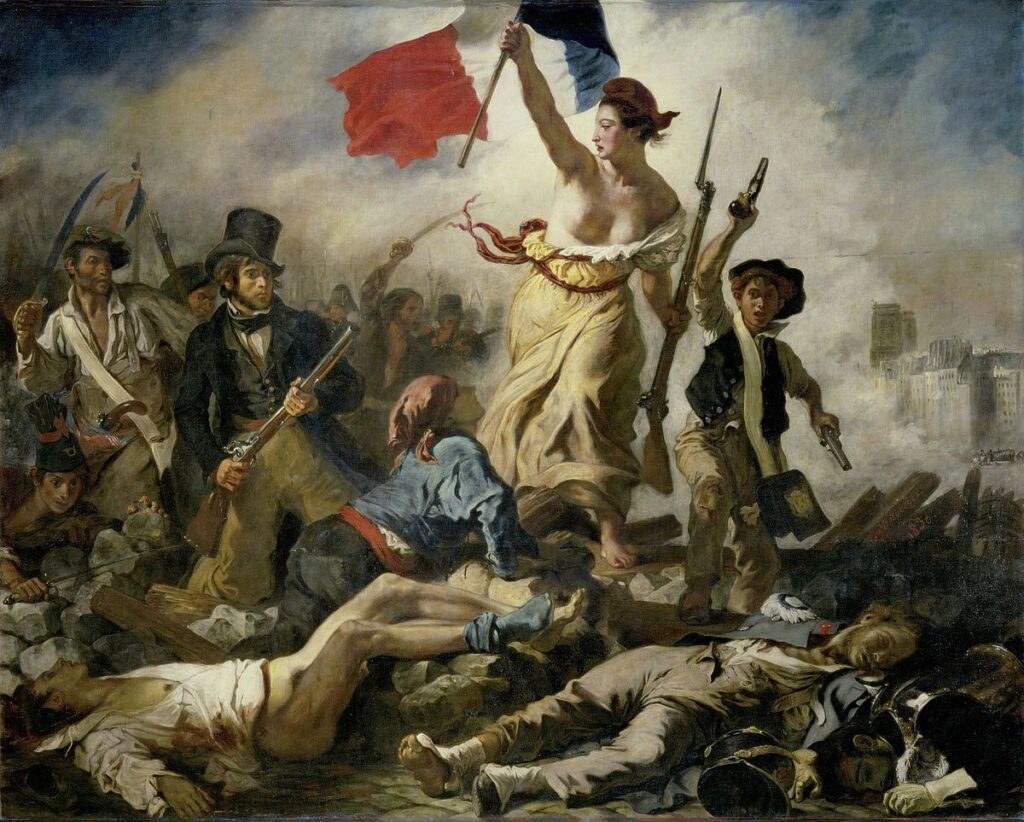
Amid the most famous Romanticism paintings ever created, Eugène Delacroix' piece of work titled Liberty Leading the People is widely considered to exist the almost well-known painting from the time menstruum. This work is famous for its captivating beauty as much equally the message of the overall scene itself.
Delacroix was known as i of the biggest supporters of a movement that is known as the July Revolution. This event occurred in France during the summer of 1830 and consisted of many of the nation's lower-class citizens revolting against King Charles Ten. The artist painted this work shortly after the revolution to commemorate the overthrow of the male monarch.
Information technology is one of the most iconic paintings in French history as it features many of the French commoners in the midst of a heated battle against the king's loyalists. Liberty, which is represented past a beautiful woman, leads a accuse toward the fray holding the French flag in one hand and a musket in the other.
2. The Raft of the Medusa – Theodore Gericault
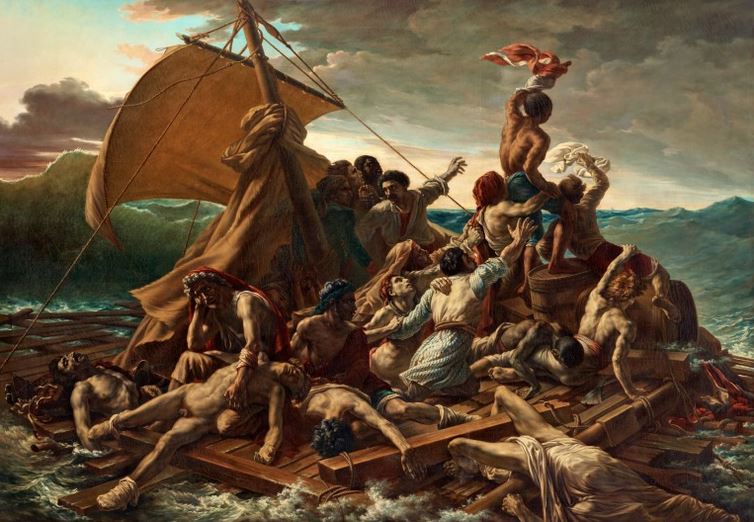
Theodore Gericault sought to commemorate the bravery and perseverance of the men aboard a ship that would become one of the most tragic maritime disasters in French history.
The Medusa, a French warship that was active during the Napoleonic Wars of the early 19th century, was lost after crashing into a big sandbank in the Atlantic Ocean in 1816.
The original crew of the ship consisted of 400 men, simply merely 151 were able to fit onto a makeshift raft that had been hastily constructed by the survivors. The raft was later on found with but 15 men nevertheless alive.
Gericault painted a work that he titled The Raft of the Medusa in 1819. The painting features the parched sailor flayed over the raft'due south surface as it floated aimlessly in the open up body of water.
Gericault'south fashion of painting is i of the near platonic examples of the Romanticism mode as it offers a high level of emotional significance.
The true story was much more than gruesome than the painting depicted as many of the surviving crewmen are said to have resorted to cannibalism in order to survive being stuck at sea for weeks in the blistering heat of the shipping lanes virtually Senegal.
Gericault is said to accept studied the result extensively before creating the masterpiece as an effort to honorably portray the events that took place later on the wreck of the Medusa.
3. Wanderer above the Body of water of Fog – Caspar David Friedrich
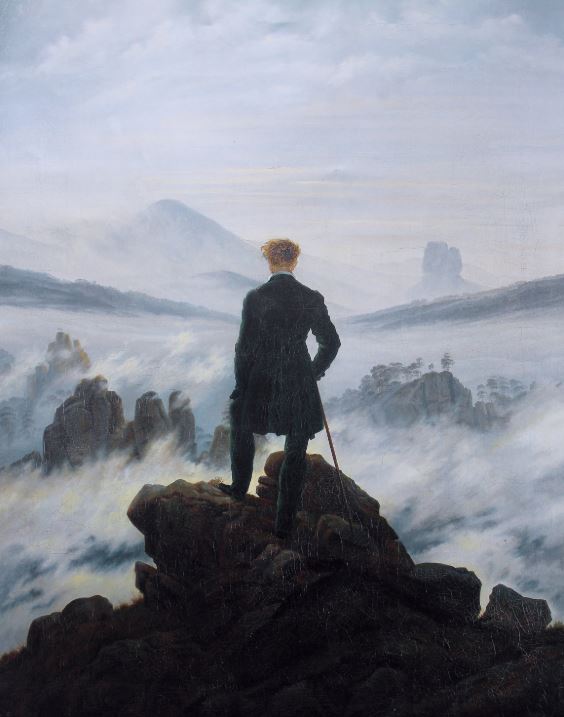
One of the more iconic paintings of the Romanticism era was done by Caspar David Friedrich in 1818. The German artist is known for his paintings that characteristic human figures prepare against starry night skies and wide open vistas.
His work titled Wanderer Above the Sea of Fog is of a similar nature every bit it portrays a young explorer perched atop a rocky outcrop, overlooking a fog-covered valley below.
The painting was washed during a time in which exploration was largely romanticized by much of Europe and the United States. Friedrich's piece of work appears to convey the sense of wonder and adventure that was and so often sought subsequently among the many explorers of the early 19th century.
This painting is one example of how Romanticism artworks were able to elevate mural works to new heights in the public center.
4. The Third of May 1808 – Francisco Goya
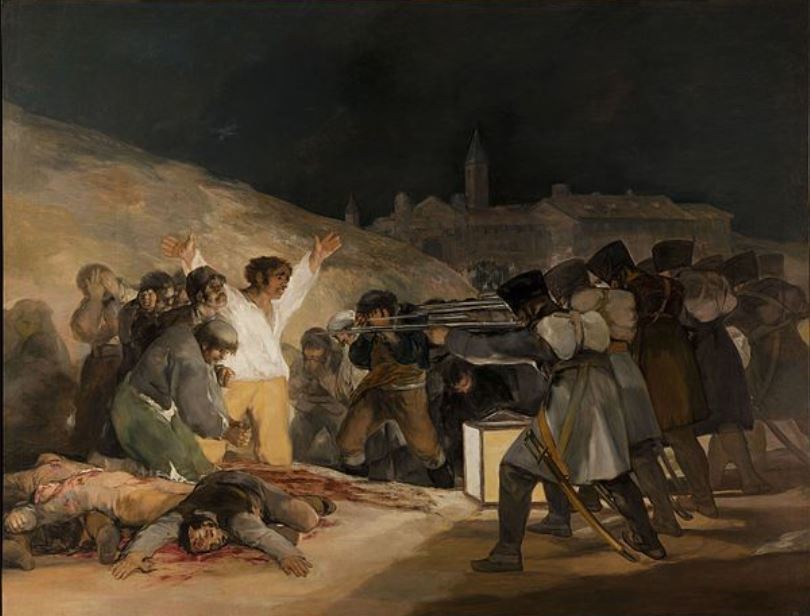
Many Romanticism artists portrayed some of the most pivotal moments in world history during the time in which they were created.
Such was the instance for Francisco Goya when he painted one of the most iconic Spanish paintings of the Romantic movement titled The Third of May 1808.
This painting was done to commemorate the events that occurred in Madrid during the commencement few days of May, 1808. The city was invaded and overtaken by Napoleon Bonaparte's army in the spring of that yr. The Spaniards that were left in the city rose upwardly against the French occupying forces on May 2, 1808 in a futile effort to take Madrid back.
Goya painted two works, one to depict the events that took place on May 2 and another that commemorated what happened on May 3 when the French soldiers brutally punished the leaders of the rebellion.
Goya'south painting portrays a valiant grouping of Spanish men in the final moments earlier their execution at the easily of a firing squad.
5. Clorinda Rescues Olindo und Sophroni – Eugène Delacroix
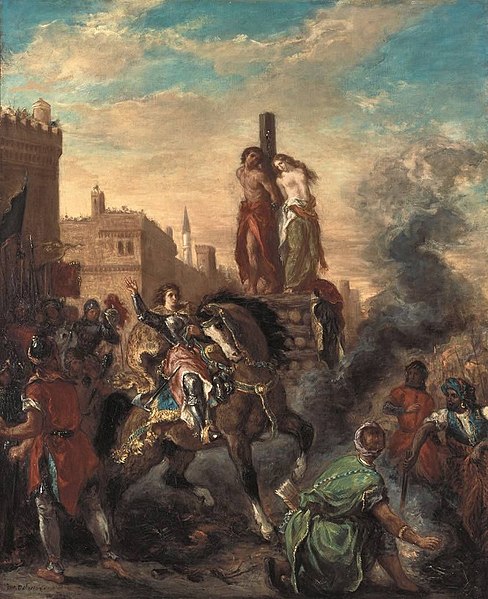
One of Eugène Delacroix' most noted works from the Romanticism movement focuses on a story taken from a pop poem by Torquato Tasso that was published in 1581.
The poem centers around the story of Clorinda, a lady known as a valiant warrior and great leader amidst the warlike culture of the Saracen army in the desert areas near Jerusalem.
Delacroix created a painting known every bit Clorinda Rescues Olindo und Sophroni in 1856. The work portrays Clorinda riding into Jerusalem to stop the execution of two lovers from the opposing regular army.
In the painting, Clorinda is seen mounted atop a warhorse riding into the crowd just as the flames begin to lick the feet of the 2 lovers who are tied to a stake.
6. Isaac Newton – William Blake
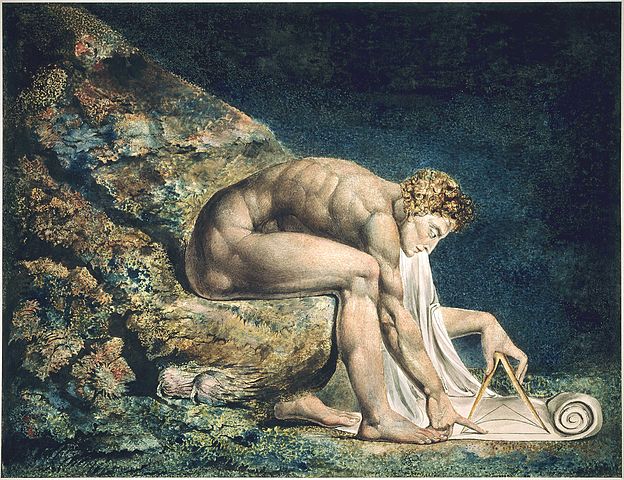
William Blake created a work that features the bully intellectual figure of the 17th and 18th centuries who was a popular meteorologist and physicist.
In the painting, which is titled Isaac Newton, Blake depicts Newton as a young and muscled figure sitting on a big stone. This depiction is a articulate departure from many other artists' works who portray Newton as an old, wise philosopher, often in deep thought.
Blake is said to have been highly critical of Newton's approach to scientific matters and painted the famous theologian and physicist as existence focused on a small piece of parchment below with geometric symbols written on it—conspicuously unaware of the beauty surrounding him.
seven. The Hay Wain – John Lawman
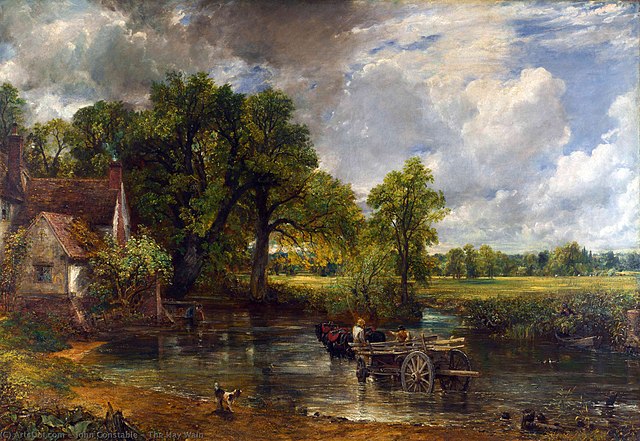
Landscapes were a huge part of the Romanticism era and John Constable was praised for his unique efforts in bringing natural settings to life. His 1821 work titled the Hay Wain is considered to be 1 of the most famous mural paintings.
Constable depicts a scene of simple English language farmers at work, using horses to pull what appears to be a hay wain across a river.
The painting is considered to be one of the nigh iconic works of rural English history and the very location from where Constable painted the masterpiece remains a pop tourist destination to this day.
8. The Kiss – Francesco Hayez
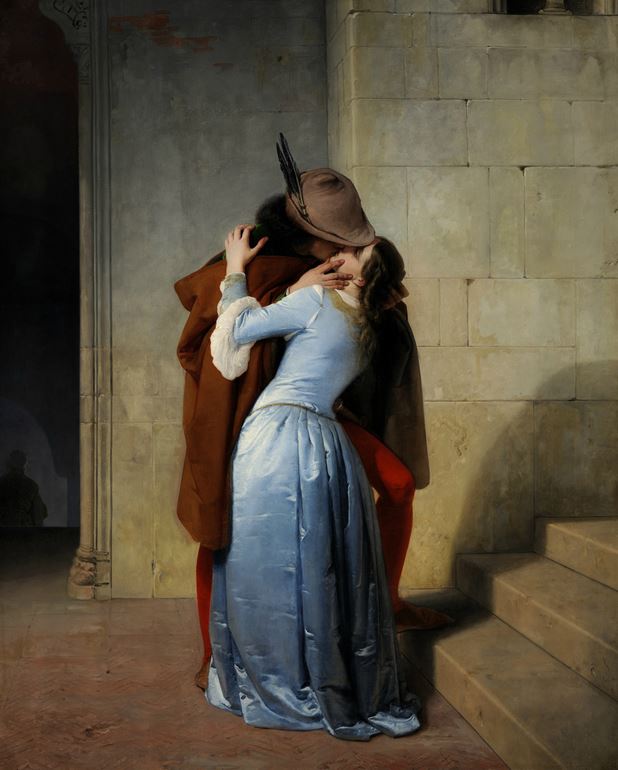
The Romanticism period is said to accept reached its peak around the center of the 19th century. Francesco Hayez created one of the era's most recognizable paintings in his work titled The Osculation.
Painted in 1859, this masterful work depicts a simple man and woman embracing i another in a sensual buss—their faces subconscious within one another.
This romantic painting is widely hailed for Hayez' incredible level of particular in every inch of the work. The Kiss is considered to be one of the virtually iconic Italian paintings in history and seems to represent a scene from the Middle Ages as indicated by the dress of both figures.
9. The Fighting Temeraire tugged to her last berth to be broken upward – J.M.W. Turner
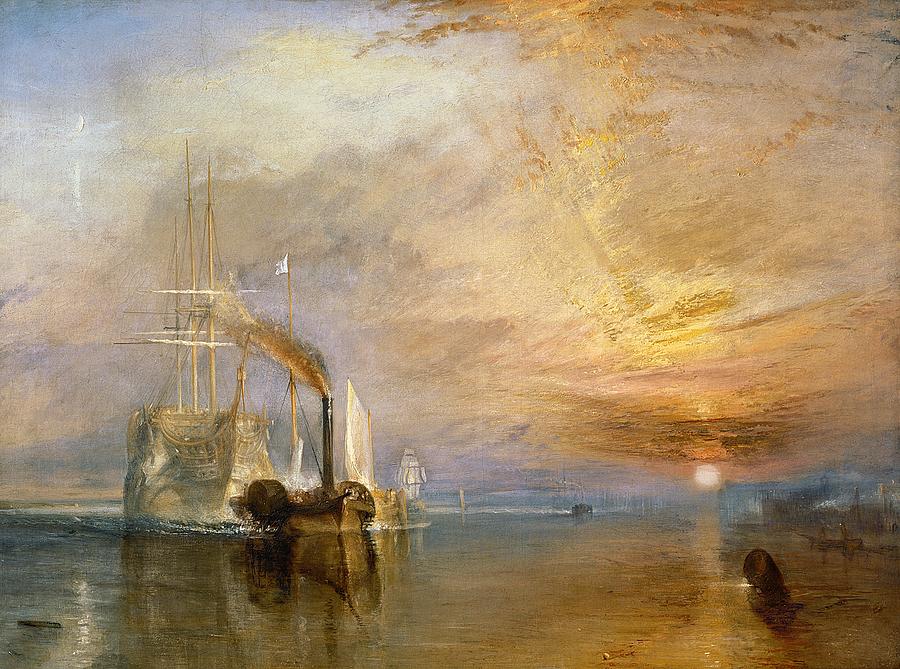
Toward the middle of the 1800's the older, majestic warships of the Purple Navy were existence replaced by the newer, more than advanced ships that featured iron hulls and other innovations. J.Thou.W. Turner sought to capture the terminal moments of i of the British Navy's most famous vessels as it was beingness towed out to sea to be scrapped.
The Temeraire was once known as one of the mightiest ships in the British Empire'south naval fleet and was credited equally i that played a cardinal role in the Battle of Trafalgar.
His 1838 work was titled The Fighting Temeraire tugged to her final berth to be broken up. The painting was one that defined the transition between the older and more graceful wooden ships toward a new era.
This is evidenced by the brusque, unattractive steamboat that is seen towing the Temeraire out to sea with the older ship seen with less coloration as if it is fading into the distance.
Turner is responsible for some of the most iconic ship paintings ever produced.
10. The 9th Wave – Ivan Aivazovsky
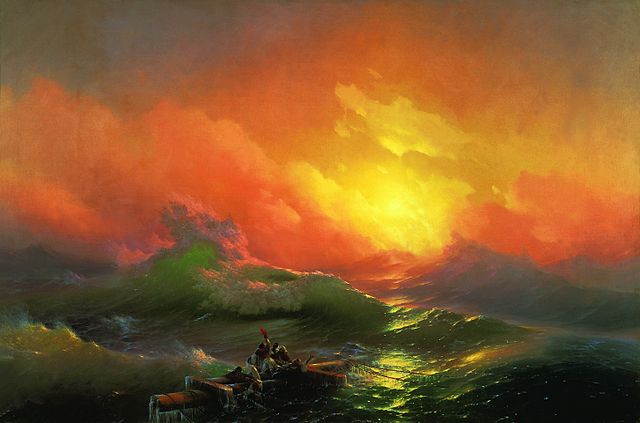
Landscapes were widely pop throughout the Romanticism movement and seascape paintings were as famous during the period across much of Europe.
Russian painter Ivan Aivazovsky was known for creating some of the most iconic ocean paintings in history. His piece of work titled The 9th Moving ridge, painted in 1850, is considered to exist one of the bang-up masterpieces of the Romanticism movement.
The painting features large waves sweeping across an open ocean, the debris from a shipwreck is depicted in the foreground. Many art critics annotation that the droppings is in the shape of a cross, which is a clear indication that the creative person meant to portray a religious meaning with Christian emphasis.
The painting'southward theme and title are based on an old tale that was held as truth to many sailors in the centuries preceding the 1800's that large waves come up in a series of nine different waves.
These waves were said to be a succession of incrementally larger waves—the ninth wave beingness the largest of all and almost destructive.
carrollouldives49.blogspot.com
Source: https://www.artst.org/famous-romanticism-paintings/
0 Response to "10 Most Famous Romanticism Paintings"
Post a Comment